 ?Mathematical formulae have been encoded as MathML and are displayed in this HTML version using MathJax in order to improve their display. Uncheck the box to turn MathJax off. This feature requires Javascript. Click on a formula to zoom.
?Mathematical formulae have been encoded as MathML and are displayed in this HTML version using MathJax in order to improve their display. Uncheck the box to turn MathJax off. This feature requires Javascript. Click on a formula to zoom.Abstract
Introduction
The potential of layered double hydroxide (LDH) as a host of multiple ultraviolet-ray absorbers was investigated by simultaneous intercalation of benzophenone 4 (B4) and Eusolex® 232 (EUS) in Zn/Al LDH.
Methods
The nanocomposites were prepared via coprecipitation method at various molar ratios of B4 and EUS.
Results
At equal molar ratios, the obtained nanocomposite showed an intercalation selectivity that is preferential to EUS. However, the selectivity ratio of intercalated anions was shown to be capable of being altered by adjusting the molar ratio of intended guests during synthesis. Dual-guest nanocomposite synthesized with B4:EUS molar ratio 3:1 (ZEB [3:1]) showed an intercalation selectivity ratio of B4:EUS =53:47. Properties of ZEB (3:1) were monitored using powder X-ray diffractometer to show a basal spacing of 21.8 Å. Direct-injection mass spectra, Fourier transform infrared spectra, and ultraviolet–visible spectra confirmed the dual intercalation of both anions into the interlayer regions of dual-guest nanocomposite. The cytotoxicity study of dual-guest nanocomposite ZEB (3:1) on human dermal fibroblast cells showed no significant toxicity until 25 μg/mL.
Conclusion
Overall, the findings demonstrate successful customization of ultraviolet-ray absorbers composition in LDH host.
Introduction
Layered double hydroxides (LDHs) can be represented by the general formula [MII1−xMIIIx(OH)2]z+An−z/n·yH2O where An− is the interlayer anion, and M and M are di- and trivalent metallic cation, respectively.Citation1 LDH consists of a structure with positively charged layers that are electrically balanced by interlayer anions. The interlayer anion can be exchanged with a variety of inorganic and organic anions. Thus, the interlayer region of the layered material can be considered as a nanovessel in which anionic molecule can be stored.
Application of the layered material as a nanometer-sized host has garnered considerable attention due to its good biocompatibility, low cytotoxicity, ease of laboratory preparation, and ease of tailoring for required physical and chemical properties.Citation1–Citation5 Simultaneous intercalation of two or more anions into the interlayer region of LDH was previously attempted with amino acids,Citation6 ligand and ligation activator,Citation7 diagnosis and therapy agents,Citation8–Citation10 herbicides,Citation11–Citation13 polymers,Citation14 nucleoside monophosphates,Citation15 and isomeric benzoates.Citation16 There is a notable paucity of scientific literature investigating interlayer region intercalation of two or more ultraviolet (UV) ray absorbents.
Eusolex® 232 (2-phenylbenzimidazole-5-sulfonic acid or EUS) is often found in sunscreen formulations due to its intense absorption at UVB wavelengths. In the past, major concerns were expressed on the usage EUS as studies on photophysical and photochemical characteristic of EUS have demonstrated the capacity of EUS to generate reactive oxygen species, including singlet oxygen, upon photoexcitation. In the cellular context, the findings suggest that the photodegraded product of EUS could possibly damage DNA, as well as proteins and lipids, through a photosensitizing mechanism.Citation17,Citation18 Another UV ray absorbent, benzophenone 4 (2-hydroxy-4-methoxybenzophenone-5- sulfonic acid or B4) is often used as active ingredient in sunscreens as it provides shielding in a broad UV spectrum and also prevents other compounds from degrading. However, recent studies have found that benzophenones are relatively easy to be absorbed into the skin and have been shown to promote generation of reactive oxygen species and display harmful properties.Citation19–Citation21
In our previous work, we have prepared Zn/Al-LDH intercalated with B4 and EUS separately. The resulting nanocomposites have shown an increase in UV ray absorption capability compared to their bulk counterparts. Additionally, simulation under skin pH medium demonstrated low release of the intercalated UV ray absorbents over an extended period of time.Citation22 In the present work, we propose simultaneous intercalation of B4 and EUS into Zn/Al-LDH via coprecipitation method. The expected advantages of encapsulating organic UV ray absorbents within the interlayer region of LDHs are 1) increased photostability, 2) decreased release from formulation to skin, and 3) absence of direct contact with skin while maintaining UV ray absorption properties of anionic guest. Cointercalation by two anionic guests is expected to exhibit selective intercalation that is influenced by guest–host interaction. Our work aims to examine factors that influence the selectivity, as well as determine whether the selectivity could be altered. The present study will help elucidate the effect of intercalation of more than one organic sunscreen molecules in LDH on the resulting thermal property, surface property, controlled release property, and UV ray absorptivity of the resulting nanocomposites.
Materials and methods
Materials
B4 (99.0%) was purchased from Norquay Technologies (Chester, PA, USA). Zinc nitrate hexahydrate (99.0%) and aluminum nitrate nanohydrate (99.0%) were obtained from PC Laboratory Chemicals (Mumbai, India) and used without further purification. EUS (99.0%) and sodium hydroxide (99.0%) from Merck (Darmstadt, Germany), dimethyl sulfoxide (DMSO) and phosphate buffer solution from Sigma-Aldrich (St Louis, MO, USA) and sodium chloride (99.0%) from HmbG Chemicals (Hamburg, Germany) were also used without further purifications.
Synthesis of Zn/Al-NO3 LDH
Zn/Al-NO3 LDH with Zn to Al molar ratio, R=2 was prepared as follows. A 250 mL mixture containing 0.1 mol/L Zn(NO3)2·6H2O and 0.05 mol/L Al(NO3)3·9H2O was precipitated with 0.5 mol/L NaOH solution under nitrogen atmosphere until the final pH of 7 was reached. The resulting white slurry was aged in an oil bath shaker at 70°C for 18 h. The resulting precipitate was retrieved via centrifugation, rinsed with deionized water several times, and dried in an oven at 70°C for 3 days. The dried LDH was powdered using a mortar and pestle.
Synthesis of dual-guest Zn/Al-LDH nanocomposite
Dual-guest Zn/Al-LDH nanocomposite was prepared by mixing 100 mL of EUS and B4 mixture solutions into 100 mL of 0.1 mol/L Zn(NO3)2·6H2O and 0.05 mol/L Al(NO3)3·9H2O under nitrogen atmosphere and vigorous stirring. The B4 and EUS mixture was prepared by keeping the concentration of B4 constant at 0.1 mol/L while varying the concentration of EUS at 0.1, 0.05, 0.033, and 0.025 mol/L to obtain B4 to EUS molar ratios of 1:1, 2:1, 3:1, and 4:1, respectively. The final pH of the solution was controlled to 8 by dropwise addition of 0.5 mol/L NaOH solution. The resulting light yellow slurry was placed in an oil bath shaker at 70°C for 18 h, before being centrifuged and rinsed with deionized water. The final light yellow solid (dual-guest nanocomposite samples) was dried in an oven at 70°C overnight and powdered using a mortar and pestle.
Characterization
Powder X-ray diffraction (PXRD) patterns were recorded using an XRD-6000 (Shimadzu, Kyoto, Japan) using CuKαradiation (λ =1.5418 Å). Fourier transform infrared (FTIR) spectra were recorded over the range of 400–4,000 cm−1 on a 1752X spectrophotometer (Perkin-Elmer, Waltham, MA, USA). Samples in solid state were measured in KBr matrix pellet obtained with a hydraulic press under 10 kPa pressure for 5 minutes. The carbon, hydrogen, and nitrogen contents in the nanocomposites were analyzed on a CHNS-932 (LECO Instruments, St Joseph, MI, USA). The metal contents of the nano-composites were determined by inductively coupled plasma atomic emission spectrometry (ICP-AES) using a Perkin-Elmer spectrophotometer model Optima 2000DV (Perkin-Elmer) under standard conditions. Thermogravimetric and differential thermogravimetric analyses (TGA/DTG) were performed on a Mettler-Toledo instrument model TGA851e (Mettler-Toledo, Greifensee, Switzerland) at a heating rate of 10°C/min in the range of 25°C–1,000°C. Surface characterization of the materials was carried out using a nitrogen gas adsorption–desorption technique at 77 K using Micromeritics, ASAP2000 (Micromeritics Instrument Corporation, Norcross, GA, USA). The surface morphology of the samples was observed by a field emission scanning electron microscopy (FESEM) using a ZEISS supra 40VP (Carl Zeiss, Oberkochen, German), and optical measurements were performed on a Shimadzu UV-visible (VIS)-near infrared (NIR) diffuse reflectance spectrometer (UV-3600 model). Direct-injection mass spectroscopy (DIMS) was performed using a Shimadzu DIMS QP5050A.
Simultaneous release of B4 and EUS from LDH nanocomposites
Simultaneous release of B4 and EUS anions from LDH host against time was measured in situ at λmax =285 and 311 nm for B4 and EUS, respectively, using a Perkin-Elmer UV–VIS spectrometer Lambda 35 (Perkin-Elmer) by adding 0.2 mg of sample into 3.5 mL of 0.5 mol/L NaCl and pH 5.5 phosphate buffer solution at room temperature. Data were collected and fit into zero-, first-, pseudo-second order, and parabolic diffusion kinetic models.
Culture of human dermal fibroblasts
Human dermal fibroblasts (HDFs) were obtained from American Type Culture Collection (ATCC), (Manassas, VA, USA) and cultured at 37°C in a humidified atmosphere of 5% CO2 with high glucose Dulbecco’s Modified Eagle’s Medium (ScienCellResearch Laboratories, Carlsbad, CA, USA) containing 2% fetal bovine serum, 0.5% penicillin– streptomycin, 1% glutamine, and 1% nonessential amino acids. For the experiment, we used a seeding density of 1×10Citation5 cells/well plated onto 96-well plates.
Cell viability assay
The cell cytotoxicity was determined by MTT colorimetric method.Citation23 In brief, cells were cultured in 96-well plates at a density of 1×10Citation5 cells/well for cytotoxicity assessment study. After being incubated for 24 h, the cells were treated to various concentrations of test compounds including synthesized nanocomposites and incubated for 24 h. After the specific incubation period, freshly prepared tetrazolium dye (MTT; Sigma-Aldrich Co., St Louis, MO, USA) was added and then converted to purple formazan. The formazan product was dissolved with 100 μL of DMSO which was added to each well. Finally, the formazan concentration from the 96-well plates was measured at 570 nm using an enzyme-linked immunosorbent assay microplate reader. Cell viability was calculated as a ratio of various test compounds exposed cells to control cells.
Results and discussion
X-ray diffraction and spatial orientation of the guest between LDH interlayers
The PXRD pattern and average basal spacing of pristine Zn/Al-NO3-LDH as well as dual-guest nanocomposite samples are shown in . Average basal spacing of Zn/Al-NO3and ZEB (3:1) nanocomposite based on 2 and 6 harmonics are summarized in
Table 1 Empirical formula and d-spacing of Zn/Al-NO3, and ZEB (3:1) nanocomposite
Figure 1 PXRD patterns of Zn/Al-NO3 and dual-guest nanocomposites prepared at various B4:EUS molar ratios.
Abbreviations: B4, benzophenone 4; EUS, Eusolex® 232; PXRD, powder X-ray diffraction; ZEB, dual-guest nanocomposite synthesized with B4 and EUS.
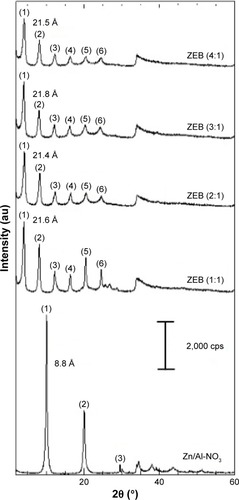
Factors such as anionic size, charge, orientation, and interaction with the positively charged inorganic interlayer affect the degree of intercalation and the separation between layers. Zn/Al-NO3–LDH showed basal spacing of 8.8 Å, a typical basal spacing shown by Zn/Al-NO3–LDH with nitrates as the counter anion.Citation24 Increment in basal spacing in UV absorber/LDH nanocomposites is due to displacement of nitrates with larger organic UV absorbing molecules. In the case of dual-guest nanocomposite samples, little difference in average basal spacing could be detected by varying the molar ratios of B4 to EUS.
Estimated dimensions of B4 and EUS anions were obtained using ChemBioOffice software (Perkin-Elmer), as shown in . The anion geometry was optimized by applying molecular mechanical MM2 energy minimization calculation available in the software. Expected gallery height that can be occupied can be deducted by subtracting the layer thickness of 4.8 Å from basal spacing obtained from PXRD analysis. A new monophasic dual-guest nanocomposite was obtained with slightly larger basal spacing from values reported for single-guest intercalation of B4 (21.3 Å) and EUS (21.0 Å).Citation22 We could attribute this to the interaction of larger molecular size of EUS with B4. We foresee bilayer arrangement by alternating charge-balancing SO3−groups above and below the layer with maximized π–π interaction between the benzene rings.Citation25 To form a bilayer arrangement, the most plausible orientation () with maximized π–π interaction between molecules of different sizes would naturally have less compatibility than that of the same molecules. Thus, the slight increment in basal spacing compared to that of single-guest nanocomposites is expected.
Figure 2 Molecular structure of and three-dimensional molecular size of B4 (A) and EUS (B) and proposed orientation of B4 and EUS in Zn/Al-LDH interlayer for the formation of dual-guest nanocomposite ZEB (3:1) (C).
Abbreviations: B4, benzophenone 4; EUS, Eusolex® 232; LDH, layered double hydroxide; ZEB (3:1), dual-guest nanocomposite synthesized with B4:EUS molar ratio 3:1.
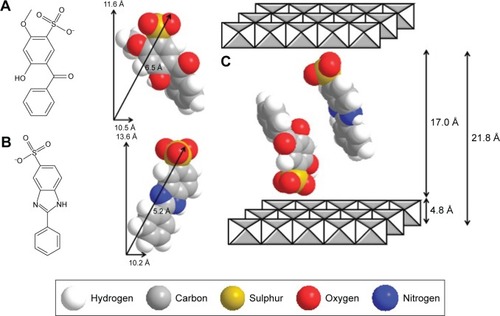
Elemental analyses
The empirical formula of Zn/Al-LDH nanocomposites listed in , was determined from ICP-AES and TGA/DTG analyses. Chemical compositions of B4, EUS, Zn/Al-NO3, and dual-guest nanocomposites are listed in .
Table 2 Chemical compositions of B4, EUS, Zn/Al-NO3, ZB4, ZEUS, and dual-guest nanocomposites
The Zn/Al molar ratios for all Zn/Al-LDH samples obtained experimentally are slightly higher than the calculated value, R=2. The slight discrepancy between calculated and observed ratio is due to the requirement to adjust the Zn to Al ratio to neutralize the charge of the anions intercalated in between the LDH interlayers.
The amount of intercalated anions was determined using UV–VIS spectrometer by treating samples with acid to disintegrate inorganic layers completely, releasing the intercalated anions. Absorbance was monitored at λmax =285 and 311 nm for B4 and EUS, respectively. Percentage loading of the dual-guest nanocomposites was determined by solving simultaneous equation below:
A summary of percentage loading of intercalated anion is listed in . Elemental analysis of dual-guest nanocomposites confirmed the cointercalation of both B4 and EUS into LDH. The results also reveal that the relative contents of the cointercalated guests in LDH could be controlled by changing the ratio of guests in the reaction media. Although B4 loading was not detected in ZEB (1:1) sample, its PXRD result showed little difference in basal spacing in comparison to the rest. Therefore, it may be possible that some intercalation of B4 had occurred in negligible concentrations.
Table 3 Competitive intercalation between B4 and EUS at different B4:EUS ratios
Simultaneous intercalation of B4 and EUS using the same B4:EUS ratios shows that LDH favors the intercalation of EUS. However, as molar ratio of B4 is increased and EUS is decreased, we could overcome the strong preference to EUS. Preferences to anion by an LDH are affected by the electrostatic attraction between positively charged metal hydroxide layer and the guest anions, hydrogen bonds between sulfoxyl oxygen atoms in the guest anions and hydroxyl hydrogen atoms in the hydroxide layers, and distribution of charges (dipole moment) in the guest anions.Citation26 Unlike EUS, B4 has two substituent groups on its aromatic ring that could influence the distribution of charges. Electron-donating –OH on the para position of sulfoxylate group may be reinforcing B4’s electrostatic attraction to the interlayer, but we believe that in the present case, the ortho position of electron-donating –OCH3group has a more significant effect because they are able to interact with hydroxyl hydrogen atoms in the hydroxide layers. Hence, low selectivity of B4 could be attributed to the antagonistic effect of –OCH3 group on the ortho position of the sulfoxylate group. As summarized in , an almost equal amount of intercalated percentage of B4 and EUS was synthesized with B4:EUS molar ratio of 3:1. Therefore, further physicochemical characterizations, UV absorptivity, and cytotoxicity studies were focused on ZEB (3:1) nanocomposite.
DIMS
Mass spectral results of EUS, B4, and the dual-guest nanocomposite ZEB (3:1) are presented in . DIMS serves as a fingerprinting tool to determine the intercalated components.
Figure 3 DIMS patterns of EUS (A), B4 (B), and dual-guest nanocomposite ZEB (3:1) (C).
Abbreviations: B4, benzophenone 4; DIMS, direct-injection mass spectroscopy; EUS, Eusolex® 232; ZEB (3:1), dual-guest nanocomposite synthesized with B4:EUS molar ratio 3:1.

Mass spectra of pure EUS showed abundant peak at m/z 274 corresponding to its molecular ion peak. Molecular ion peak for B4 meanwhile was slightly less prominent and was preceded by M-1 peak at m/z 307 resulting from the loss of hydrogen radical. We focused on ZEB (3:1) sample as it consisted of almost equal percentage of intercalated B4 and EUS. DIMS pattern of ZEB (3:1) gave rise to a peak at m/z 194, corresponding to [C13H10N2]+, a product of desulfonated fragment ion of EUS. The comparatively higher intensity of fragmentation ion [C7H3O]+ (m/z 105) and [C8H7O]+ (m/z 151) comes from further fragmentation of desulfonated product of B4 [C14H14O3]+ (m/z 231). High intensity at m/z 78 corresponds to deprotonated benzene which could be attributed to fragmentation of either intercalated anions.Citation27,Citation28 Peaks coinciding with molar mass of B4 and EUS could not be detected in our dual-guest nanocomposite. This phenomenon could be due to intermolecular bonding between dual-guest anions in the layered matrix that resulted in more complex mass fragmentation than a single-guest anion intercalation.
The observed fragmentation peaks confirm the cointercalation of both anions B4 and EUS in the LDH host. It is worth noting that ZEB (3:1) showed more prominent peaks assigned to B4 than EUS. The abundance of fragment ions representing B4 suggests higher intercalated ratio for B4 in the samples ZEB (3:1), which is in agreement with the results presented in .
FTIR spectroscopy
The FTIR spectra of B4, EUS, Zn/Al-NO3, and dual-guest ZEB nanocomposites are displayed in .
Figure 4 FTIR spectra of Zn/Al-NO3, B4, EUS, and dual-guest intercalated products; ZEB (1:1), ZEB (2:1), ZEB (3:1), and ZEB (4:1).
Abbreviations: B4, benzophenone 4; EUS, Eusolex® 232; FTIR, Fourier transform infrared; ZEB, dual-guest nanocomposite synthesized with B4 and EUS.
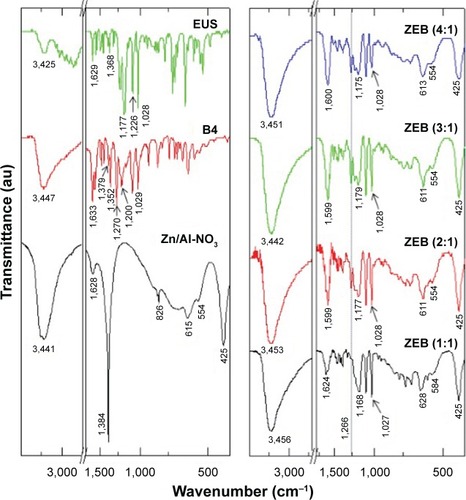
The FTIR spectra for both Zn/Al-NO3 and dual-guest nanocomposites show a broad absorption band commonly observed in the LDH materials centered at around 3,500 cm−1due to the presence of O-H stretching mode of the hydroxyl group physisorbed onto LDH layers, as well as interlayer water molecules.Citation29 A weak band corresponding to the stretching vibration of H-OH appears at 1,628 cm−1.Citation30 Bands in the low-frequency region correspond to translational vibration modes of Zn-OH at 611–615 cm−1, Al-OH at around 554 cm−1, and deformation of HO-Zn-Al-OH at 425 cm−1. A sharp peak at 1,384 cm−1 is attributed to NO3−as an interlayer anion of Zn/Al-NO3. This peak was completely removed from ZEB nanocomposite as the intercalation of anions B4 and EUS has taken place.
FTIR spectra of pure B4 show peaks at 1,200 cm−1(symmetric) and 1,029 cm−1 (asymmetric), stretching of SO3− group, 1,596 cm−1, 1,490 cm−1, and 1,446 cm−1 for C=C vibrations of aromatic ring, 1,379 cm−1 (in plane deformation vibration of CH3), 1,352 cm−1(R-SO2-OH stretch), and 1,270 cm−1 (Ar-O-CH3). The FTIR spectra of pure EUS show peaks at 1,567 cm−1, 1,497 cm−1, and 1,455 cm−1 for C=C vibrations of aromatic ring, 1,368 cm−1 (R-SO2-OH stretch), 1,226 cm−1, and 1,177 cm−1 (C=N stretch), 3,425 cm−1 (N-H stretching), and 1,629 cm−1 (N-H bending). Due to the intense vibration of a C=N stretching at around 1,200 cm−1 range, only asymmetric vibration band of sulfonate group could be detected at 1,028 cm−1.
When equal molar concentration was used, B4 failed to intercalate in a substantial amount. This was evident in the FTIR spectra of dual-guest nanocomposite as no observation of vibration band that could be assigned to O-CH3 was detected at 1,600 cm−1 (attributing to B4) for the ZEB (1:1) sample. Instead, a broad peak centered at 1,624 cm−1 was detected, a characteristic of N-H bending of EUS. This is in accordance with high preference intercalation by EUS as shown by the UV–VIS analysis (). Successful intercalation of B4 was confirmed with the presence of Ar-O-CH3stretching at 1,266 cm−1 for samples ZEB (2:1), ZEB (3:1), and ZEB (4:1). This nanocomposite exhibits most of the vibrational bands that can be assigned to respective guests. However, several vibrations were shifted due to interaction between guest anions and the interlayer. Absorption band corresponding to R-SO2-OH was not observed after intercalation due to immobilization of sulfoxylic guests within the LDH host.
Thermal analysis
TGA/DTG measurement of B4, EUS, Zn/Al-NO3, and dual-guest ZEB (3:1) nanocomposites are shown in . TGA/DTG thermograms exhibit the thermal decomposition behavior of samples.
Figure 5 TGA/DTG analyses of B4 (A), EUS (B), Zn/Al-NO3 (C), and dual-guest nanocomposite ZEB (3:1) (D).
Abbreviations: B4, benzophenone 4; EUS, Eusolex® 232; TGA/DTG, thermogravimetric and differential thermogravimetric analyses; ZEB (3:1), dual-guest nanocomposite synthesized with B4:EUS molar ratio 3:1.
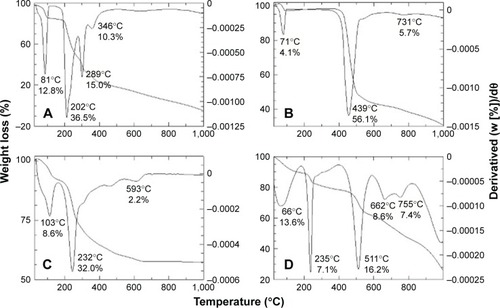
Thermal decomposition of UV absorber B4 occurs in four stages. The first at the maximum temperature 81°C is most probably due to the removal of moisture in the sample. The rest of the stages can be attributed to decomposition and combustion of the organic compound up until the maximum temperature of 350°C. Pure B4 did not completely decompose at temperature until 1,000°C.
Thermal decomposition profile of EUS shows three main events. The first one corresponds to the removal of moisture and the subsequent stages correspond to decomposition and combustion of organic matter. However not all compounds were decomposed, as DTG curve showed weight loss peak coming up after 450°C and continuing above our analysis condition limit.
TGA/DTG curves of Zn/Al-NO3 LDH in show three weight loss stages. The first event is attributed to loss of physisorbed and interlayer water molecules. The second and most prominent peak corresponds to dehydroxylation of LDH matrix, while the last step is linked to decomposition of intercalated nitrates.Citation31 Thermal decomposition eventually reached completion at around 680°C.
Dual-guest nanocomposite ZEB (3:1) showed characteristic decomposition peaks of LDHs with its first two weight loss events. Subsequent weight loss events centered at 511, 662, and 755°C are attributed to the decomposition of intercalated organic species. It should be noted that the thermal decomposition region of dual-guest nanocomposite is significantly higher than pure B4 and EUS. This indicates that the thermal stability is enhanced due to interaction between B4 and EUS and the layered structure.
Surface morphology
FESEM images of Zn/Al-NO3 and dual-guest ZEB (3:1) nanocomposite are shown in .
Figure 6 FESEM images of Zn/Al-NO3 at 50,000× magnification (A) and dual-guest nanocomposite ZEB (3:1) at 50,000× magnification (B).
Abbreviations: B4, benzophenone 4; EUS, Eusolex® 232; FESEM, field electron scanning electron microscopy; ZEB (3:1), dual-guest nanocomposite synthesized with B4:EUS molar ratio 3:1.
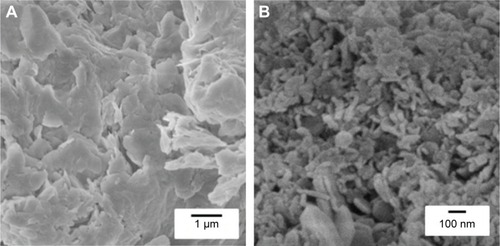
Pristine Zn/Al-NO3 consisted of agglomerates of very thin nonuniform plate particles with sharp edges. Single intercalation of EUS and B4 reported morphologies of plate-like structures with blunt edges. The former showed 50–500 nm in size, while the latter showed smaller sizes (ca. 25–100 nm). Dual-guest nanocomposite, ZEB (3:1) showed a morphology similar to that of Zn/Al-B4 but with less agglomeration and sizes ranging from 20 to <100 nm. Furthermore, the dual-guest nanocomposite exhibited an increase in particle thickness compared to the pristine LDH.
shows the nitrogen adsorption–desorption isotherms of Zn/Al-NO3 and dual-guest ZEB nanocomposites. The nanocomposites depict Type IV isotherm by the International Union of Pure and Applied Chemistry (IUPAC) classification.Citation32 According to IUPAC classification, the type of hysteresis loop for these nanocomposites can be classified as H3-type hysteresis loop. This type of loop is typical for mesoporous materials comprised of agglomerates of plate-like particles with slit-shaped pores.
Figure 7 Adsorption–desorption isotherms of Zn/Al-NO3 (inset) and dual-guest nanocomposite ZEB (3:1).
Abbreviations: B4, benzophenone 4; EUS, Eusolex® 232; STP, standard temperature and pressure; ZEB (3:1), dual-guest nanocomposite synthesized with B4:EUS molar ratio 3:1.
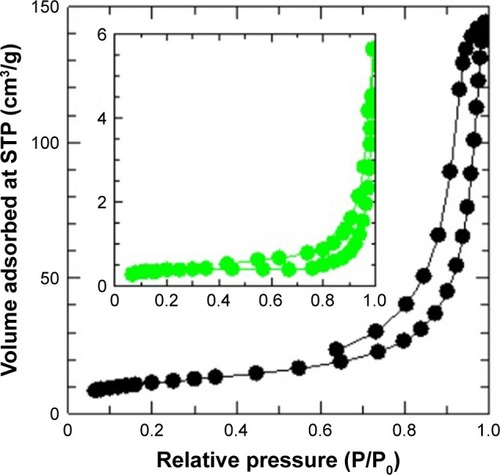
shows the Barrett–Joyner–Halenda method (BJH) desorption pore size distribution for Zn/Al-NO3and dual-guest nanocomposite ZEB (3:1). Pore size distribution showed a wide distribution of pore diameter for pristine Zn/Al-NO3 (inset). On the other hand, dual-guest nanocomposite, ZEB (3:1) (outset), showed a single-peaked pore diameter distribution centered at 245 Å.
Figure 8 BJH pore size distribution of Zn/Al-NO3 (inset) and dual-guest nanocomposite ZEB prepared at B4:EUS =3:1.
Abbreviations: B4, benzophenone 4; BJH, Barrett–Joyner–Halenda; EUS, Eusolex® 232; ZEB (3:1), dual-guest nanocomposite synthesized with B4:EUS molar ratio 3:1.

A summary of Brunauer, Emmett, and Teller method surface area, BJH pore volume, and BJH pore diameter for the nanocomposites is given in .
Table 4 Surface properties of Zn/Al-NO3 and ZEB (3:1) nano-composites
Varying wideness of desorption branch of the hysteresis loop and pore diameter suggests different pore texture as a result of LDH gallery occupation by different guest anions.
UV ray absorption ability analysis
Solid-state absorbance spectra of B4, EUS, Zn/Al-NO3-LDH, and dual-guest nanocomposites are shown in .
Figure 9 Solid-state absorbance spectra of B4, EUS, Zn/Al-NO3, and dual-guest intercalated products; ZEB (1:1), ZEB (2:1), ZEB (3:1), and ZEB (4:1).
Abbreviations: B4, benzophenone 4; EUS, Eusolex® 232; ZEB, dual-guest nano-composite synthesized with B4 and EUS.
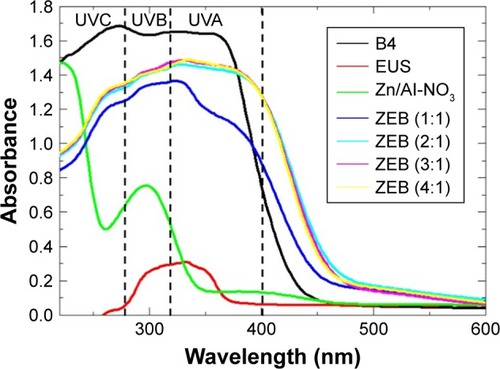
B4 showed a strong ability to absorb both UVB (280–320 nm) and UVA (320–400 nm), while EUS showed a weak ability to absorb short UVA. UVA absorption ability of B4 was superior to that of EUS. This is due to the sub-stituent of aromatic ring in B4, the methoxy group, and the hydroxy group.Citation33 UV absorption ability of pristine Zn/Al-NO3LDH was shown to be poor. UV absorption peak at 300 nm for Zn/Al-NO3 is ascribed to the presence of NO −3 in LDH interlayer.Citation34
However, as a result of intercalation with UV ray absorbing molecules, LDH nanocomposites exhibit broad and strong UV-shielding capability that mimics intercalated compound. This is an indication that the inorganic lattice retains UV absorbent molecules and attains chromophores that influence absorption characteristic of those molecules. The effect of broadened absorption range is due to spatial confinement and host–guest interactions, namely electrostatic attraction, hydrogen bonding, and van der Waals forces.
The dual-guest nanocomposite experienced an absorption peak shift to the higher wavelength region, also known as red shift, which happened as a result of edge-to-edge arrangement of intercalated B4 and EUS molecules () when electron-donating groups –OCH3 and –OH induced conjugation.Citation35 UV absorption spectrum of dual-guest nanocomposites showed that the ratio of guest anions intercalated does not impart a significant effect on absorption range or intensity. ZEB nanocomposites maintained a broad and intense absorption similar to that of the organic UV absorbent, B4. A slight decrease in absorption ability in comparison to B4 can be attributed to the dilution effect of intercalation in LDH host. UV rays in sunlight which reach the ground are mainly UVA (90%–99%) and UVB (1%–10%).Citation36 Therefore, a shift to the UVA range as observed is preferable for higher protection against the sun. Although B4 loading was not detected in the ZEB (1:1) sample by FTIR and UV–VIS spectrometer, solid-state absorbance spectrum of ZEB (1:1) showed broad absorbance that is more similar to B4 intercalation rather than EUS. Thus, it may be possible that intercalation and surface absorption of B4 had occurred at a negligible amount that could not be detected by FTIR or UV–VIS spectrometer.
UV absorption spectrum corresponds to electron excitation from valence band to conduction band. The spectrum can be used to determine the band gap values using the Kubelka–Munk equation:Citation37
Figure 10 Kubelka–Munk transformed reflectance spectra of Zn/Al-NO3 (A), B4 (B), EUS (C), and dual-guest intercalated product; ZEB (3:1) (D).
Abbreviations: B4, benzophenone 4; EUS, Eusolex® 232; ZEB (3:1), dual-guest nanocomposite synthesized with B4:EUS molar ratio 3:1.

Pristine Zn/Al-NO3 showed a single band gap at 5.11 eV. B4 exhibited band gaps at 3.22 and 3.65 eV, while EUS exhibited a single band gap at 5.20 eV. Dual-guest nano-composites ZEB (3:1) exhibited a shift to narrower band gap values, 2.60 and 2.97 eV. A narrower band gap value accounts for its high visible-light photocatalytic availability.Citation38 It is generally known that high photocatalytic activity is brought upon by high specific surface area.Citation39 Thus, we could attribute the shift to narrower band gap value to the specific surface area increase pattern, as discussed in the “Surface morphology” section.
Retention of sunscreen molecules in dual-guest nanocomposites
Interlayer anions of LDH are held by weak electrostatic attraction and can be exchanged with anions of higher affinity to the layered host. Retention of organic sunscreen molecules in LDH matrices was studied in a release medium of 0.5 mol/L NaCl () and pH 5.5 phosphate buffer () using a dual-guest sample prepared at B4:EUS =3:1. ZEB (3:1) nanocomposite was selected as it contains almost equal percentage of intercalated anion. Respective release media were chosen in order to simulate the application condition of the new sunscreen formulation. 0.5 mol/L NaCl represented artificial sea water, while pH 5.5 phosphate buffer reproduced skin pH condition.
Figure 11 Controlled release of B4 (□) and EUS (∆) from dual-guest nanocomposite ZEB (3:1) in 0.5 mol/L NaCl (A) and pH 5.5 phosphate buffer solution (B).
Abbreviations: B4, benzophenone 4; EUS, Eusolex® 232; ZEB (3:1), dual-guest nanocomposite synthesized with B4:EUS molar ratio 3:1.
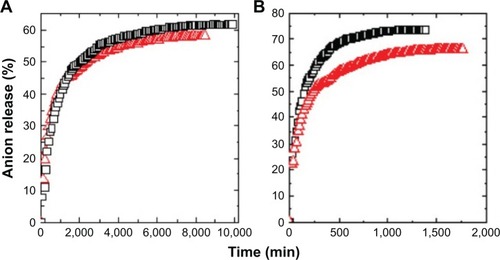
The release profiles showed that accumulated release was rapid for the first 4 hours of contact with pH 5.5 phosphate buffer. Then, the release slowed down until equilibrium was achieved of about 73.65% and 65.98% for B4 and EUS, respectively, after 1,250 minutes (roughly 20 hours). Similarly, in the case of artificial sea water, for the first 2,000 minutes, rapid release was observed. The release was progressively slower after that and achieved a maximum accumulated release of 61.86% and 58.24% for B4 and EUS, respectively, after almost 7 days in artificial sea water. It was predetermined that sample ZEB prepared at B4:EUS =3:1 contained a larger amount of intercalated B4. Therefore, higher release of B4 than EUS is expected.
Although the release of sunscreen molecules from the formulation was observed, the results demonstrated that direct contact of sunscreen molecules with skin could be reduced with inhibition of UV absorbents in the LDH host. Furthermore, the inorganic metal layer extended UV protection compared to pure sunscreen compounds. This was achieved by retention in host and eventually slowing down of the exposure of sunscreen molecules to photodegradable conditions.
Release kinetics of EUS and B4 from ZEB nanocomposite
Kinetic release of UV absorbing anions from ZEB (3:1) nanocomposite was investigated by fitting the release profiles of the EUS and B4 into the following kinetic models; zeroth-(EquationEq 4(4) ),Citation40 first- (EquationEq 5
(5) ),Citation41 pseudo-second order kinetics (EquationEq 6
(6) ),Citation42 and parabolic diffusion (EquationEq 7
(7) ).Citation43 The equations are expressed below, where c is a constant, and Ceq and Ct are the concentration of anion at equilibrium and time t, respectively.
The fitting results are shown in . Correlation coefficient values for all kinetic models are summarized in .
Table 5 Correlation coefficient, rate constant, and half time obtained by fitting the release data of B4 and EUS from ZEB (3:1) into various media using zeroth-, first-, pseudo-second order, and parabolic diffusion kinetic models
Figure 12 Fitting the data release of B4 (□) and EUS (∆) from dual-guest nanocomposite ZEB (3:1) into media for zeroth-, first-, pseudo-second order, and parabolic diffusion kinetics for 0.5 mol/L NaCl (A, C, E, and G, respectively) and pH 5.5 phosphate buffer solution (B, D, F, and H, respectively).
Abbreviations: B4, benzophenone 4; EUS, Eusolex® 232; ZEB (3:1), dual-guest nanocomposite synthesized with B4:EUS molar ratio 3:1.
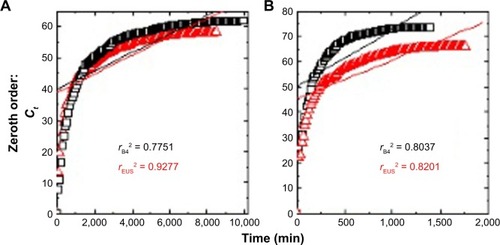
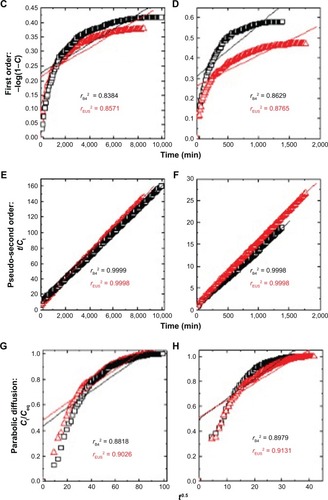
By comparing the correlation coefficient values, we found that the release patterns of EUS and B4 anions from LDH host best fit the pseudo-second order kinetic.
Using the pseudo-second order equation, we could calculate the t1/2 value. t1/2 is defined as time taken for the release to be half of the accumulated release. t1/2 values for release in pH 5.5 phosphate buffer solution were 75 and 98 min for B4 and EUS release, respectively. On the other hand, t1/2 values for release in 0.5 mol/L NaCl were 619 and 479 min for B4 and EUS, respectively. Release rate constant, k, quantifies the speed of anion release. As can be seen in , the rate constants for release in skin pH condition are 2.44×10−5 and 3.40×10−5 L mg−1 min−1 for B4 and EUS anions, respectively. In artificial seawater, the rate constants are 1.70×10−4 and 1.47×10−4 L mg−1 min−1 for B4 and EUS anions, respectively.
Higher t1/2 value and lower k value indicate slower release of the anion from the LDH interlayer. As supported by t1/2 and k values, anion release under skin pH condition was significantly faster than artificial seawater. This can be explained by the slight dissolution of LDH under a slightly acidic condition.Citation44 Moreover, the presence of phosphate combined with other anions in phosphate buffer solution induces multiple hydrolysis of phosphate and speeds up the ion-exchange process.Citation45,Citation46 Slower release in 0.5 mol/L NaCl was attributed to the low ion-exchange affinity of the incoming anion, chloride, toward the interlayer gallery of LDH.Citation47
Cytotoxicity induction on HDF cells
Cytotoxicity induced by the nanocomposite and test compounds on HDF cells was investigated by cell viability assays. HDF cells were exposed to the LDH nanocomposites B4 and EUS at the concentrations of 1.562, 3.125, 6.25, 12.5, 25, and 50 μg/mL for 24 h and cell viabilities were determined by MTT assay. The cytotoxicity findings have shown that pristine Zn/Al-NO3-LDH, pure guest, B4 and EUS, as well as dual-guest nanocomposite ZEB (3:1) up to the test concentration of 25 μg/mL did not produce any significant cytotoxicity to HDF cells. Irrespective of intercalation of two active agents of sunscreen into the LDH matrix, the dual-guest nanocomposite maintained a nontoxic nature up to 25 μg/mL. As the concentrations of all samples were increased to 50 μg/mL, cytotoxicity was observed to significantly increase ().
Figure 13 Concentration–response curves obtained by plotting the percentage of viability of HDF cells exposed to B4, EUS, nanocomposite ZEB (3:1), and Zn/Al-NO3 for 24 hours.
Note: Results are presented as mean ± SD of triplicate values.
Abbreviations: B4, benzophenone 4; EUS, Eusolex® 232; HDF, human dermal fibroblast; ZEB, dual-guest nanocomposite synthesized with B4:EUS molar ratio 3:1.
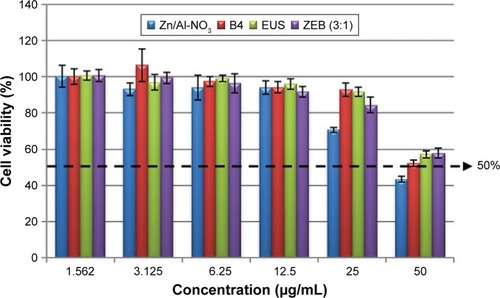
Therefore, we concluded that the cytotoxicity of samples acted in a dose-dependent manner. Based on this fruitful investigation, we will use the nontoxic concentration of the dual-guest nanocomposites for further therapeutic investigations.
Conclusion
The present study was designed to determine the effect of simultaneous intercalation of UV ray absorbent agents in Zn/Al-LDH on its resulting properties. It was discovered that using equimolar concentrations of B4 and EUS intercalation selectivity is favorable to EUS. Based on the results presented, we have demonstrated that this selectivity is tuneable by changing the molar ratio of the guests during the synthesis. We could manipulate this nature to ration out guests, and thus produce nanocomposites of customized composition. Dual-guest nanocomposites combined showed excellent absorption capacity in the UV region of both guest anions while the inorganic host improved thermal stability, broadened UV absorptivity range, and provided retention of photodegradable organic UV ray absorbing molecules. The cytotoxicity study of dual-guest nanocomposites ZEB (3:1) on dermal cells showed no significant toxicity up to 25 μg/mL. However, further therapeutic study is required to shed light on the toxicity mechanism of LDH nanocomposite on dermal cells. Even though the intercalated guest could be released from LDH host during application on skin via ion exchange, a simulation in sea water and pH of skin showed a slowing down of exposure of sunscreen molecules to photodegradable conditions. These findings demonstrate the potential for UV ray absorbent guest-intercalated LDHs to be used as a versatile, efficient, and tailor-made sunscreen formulation.
Acknowledgments
The work was financed by NanoMalaysia Institute for Innovative Technology (NanoMITe) grant under two vot numbers, namely, 9443100 and 5526300.
Disclosure
The authors report no conflicts of interest in this work.
References
- XuZPWalkerTLLiuKCooperHMLuGQMBartlettPFLayered double hydroxide nanoparticles as cellular delivery vectors of super-coiled plasmid DNAInt J Nanomed200722163174
- HoyoCDLayered double hydroxides and human health: An overviewAppl Clay Sci200736103121
- ChoyJChoiSOhJParkTClay minerals and layered double hydroxides for novel biological applicationsAppl Clay Sci2007361–3122132
- HusseinMZAliSHAZainalZHakimMNDevelopment of antipro-liferative nanohybrid compound with controlled release property using ellagic acid as the active agentInt J Nanomed2011613731383
- RivesVdel ArcoMMartínCLayered double hydroxides as drug carriers and for controlled release of non-steroidal anti-inflammatory drugs (NSAIDs): a reviewJ Control Release20131691–2283923583707
- TranHNLinCCChaoHPAmino acids-intercalated Mg/Al layered double hydroxides as dual-electronic adsorbent for effective removal of cationic and oxyanionic metal ionsSep Purif Technol20181923645
- KangHKimMFengQNanolayered hybrid mediates synergistic co-delivery of ligand and ligation activator for inducing stem cell differentiation and tissue healingBiomaterials2017149122828988061
- UsmanMSHusseinMZFakuraziSMasarudinMJSaadFFAGadolinium-doped gallic acid-zinc/aluminium-layered double hydroxide/gold theranostic nanoparticles for a bimodal magnetic resonance imaging and drug delivery systemNanomaterials (Basel)201779244
- GuanSLiangRLiCWeiMA supramolecular material for dual-modal imaging and targeted cancer therapyTalanta201716529730328153257
- GuanSWengYLiMAn NIR-sensitive layered supramolecular nanovehicle for combined dual-modal imaging and synergistic therapyNanoscale2017929103671037428702600
- SarijoSHGhazaliSAISMHusseinMZSynthesis of dual herbicides-intercalated hydrotalcite-like nanohybrid compound with simultaneous controlled release propertyJ Porous Mater2015222473480
- HusseinMZRahmanNSSASarijoSHZainalZSynthesis of a monophasic nanohybrid for a controlled release formulation of two active agents simultaneouslyAppl Clay Sci2012586066
- LiSShenYXiaoMLiuDFanLZhangZSimultaneous intercalation of 1-naphthylacetic acid and indole-3-butyric acid into layered double hydroxides and controlled release propertiesJ Nanomater2014201419
- ShiSGuoFXiaYSuZChenXWeiMPreparation of acrylic acid and AMPS cointercalated layered double hydroxide and its application for superabsorbentJ Appl Polymer Sci2011121316611668
- LotschBMillangeFWaltonRIO’HareDSeparation of nucleoside monophosphates using preferential anion exchange intercalation in layered double hydroxidesSolid State Sci200138883886
- LeiLKhanAO’hareDSelective anion-exchange intercalation of isomeric benzoate anions into the layered double hydroxide [LiAl2(OH)6] Cl·H2OJ Solid State Chem20051781236483654
- BastienNMillauJRouabhiaMDaviesHDrouinRThe sunscreen agent 2-phenylbenzimidazole-5-sulfonic acid photosensitizes the formation of oxidized guanines in cellulo after UVA or UVB exposureJ Invest Dermatol2010130102463247120574440
- InbarajJJBilskiPChignellCFPhotophysical and photochemical studies of 2-phenylbenzimidazole and UVB sunscreen 2-phenylbenzimidazole-5-sulfonic acidPhotochem Photobiol200275210711611883597
- HayashiTOkamotoYUedaKKojimaNFormation of estrogenic products from benzophenone after exposure to sunlightToxicol Lett200616711717010539
- DemirkiranOMesaikMABeynekHAbbaskhanAChoudharyMICellular reactive oxygen species inhibitory constituents of hypericum thasium grisebPhytochem2009702244249
- VilelaFMFonsecaYMJaborJRVicentiniFTFonsecaMJEffect of ultraviolet filters on skin superoxide dismutase activity in hairless mice after a single dose of ultraviolet radiationEur J Pharm Biopharm201280238739222036989
- MohsinSMNHusseinMZSarijoSHFakuraziSArulselvanPHinTYCharacterizations and cytotoxicity assessment of UV absorbers-intercalated zinc/aluminium layered double hydroxides on dermal fibroblast cellsSci Adv Mater201464111
- HeQYinSSatoTSynthesis and photochemical properties of zinc- aluminum layered double hydroxide/organic UV ray absorbing molecule/silica nanocompositesJ Phys Chem Solids2004652–3395402
- MohsinSMHusseinMZSarijoSHFakuraziSArulselvanPHinTYSynthesis of (cinnamate-zinc layered hydroxide) intercalation compound for sunscreen applicationChem Cent J2013712623383738
- PerioliLNocchettiMAmbrogiVLatteriniLRossiCCostantinoUSunscreen immobilization on ZnAl-hydrotalcite for new cosmetic formulationsMicropor Mesopor Mat20081071–2180189
- RodilRQuintanaJBLópez-MahíaPMuniategui-LorenzoSPrada-RodríguezDMulticlass determination of sunscreen chemicals in water samples by liquid chromatography-tandem mass spectrometryAnal Chem20088041307131518217772
- ZhangWWilsonCRDanielsonNDIndirect fluorescent determination of selected nitro-aromatic and pharmaceutical compounds via UV-photolysis of 2-phenylbenzimidazole-5-sulfonateTalanta20087451400140718371796
- IshikawaTMatsumotoKKandoriKNakayamaTSynthesis of layered zinc hydroxide chlorides in the presence of Al(III)J Solid State Chem2006179411101118
- ZhangSChenJQiaoXGeLCaiXNaGQuantum chemical investigation and experimental verification on the aquatic photochemistry of the sunscreen 2-phenylbenzimidazole-5-sulfonic acidEnviron Sci Technol201044197484749020836551
- FrunzaMHritcuDPopaMIIntercalation of salicylic acid into ZnAl layered double hydroxides by ion-exchange and percipitation methodJ Optoelectron Adv Mat2009114528534
- SunWHeQLuoYSynthesis and properties of cinnamic acid series organic UV ray absorbents-interleaved layered double hydroxidesMater Lett2007618–918811884
- ArizagaGGMangrichASda GardolinskiJEWypychFChemical modification of zinc hydroxide nitrate and Zn-Al-layered double hydroxide with dicarboxylic acidsJ Colloid Interf Sci20083201168176
- TouatiSMansouriHBengueddachARoyAForanoCPrevotVNanostructured layered double hydroxide aerogels with enhanced adsorption propertiesChem Commun (Camb)201248577197719922688119
- ChaiHXuXLinYEvansDGLiDSynthesis and UV absorption properties of 2,3-dihydroxynaphthalene-6-sulfonate anion-intercalated Zn–Al layered double hydroxidesPolymer Degrad Stabil2009944744749
- MarangoniRTaviot-GuehoCIllaikAWypychFLerouxFOrganic inorganic dye filler for polymer: Blue-coloured layered double hydroxides into polystyreneJ Colloid Interface Sci2008326236637318620362
- VerschootenLDeclercqLGarmynMAdaptive response of the skin to UVB damage: role of the p53 proteinInt J Cosmetic Sci200628117
- AhmedAAATalibZAHusseinMZZakariaAZn–Al layered double hydroxide prepared at different molar ratios: preparation, characterization, optical and dielectric propertiesJ Solid State Chem2012191271278
- ParidaKMMohapatraLCarbonate intercalated Zn/Fe layered double hydroxide: A novel photocatalyst for the enhanced photo degradation of azo eyesChem Eng J2012179131139
- ShaoMHanJWeiMEvansDGDuanXThe synthesis of hierarchical Zn-Ti layered double hydroxide for efficient visible-light photocatalysisChem Eng J20111682519524
- CostaPLoboJMSModeling and comparison of dissolution profilesEur J Pharm Sci200113212313311297896
- SinghJGuptaSKaurHPrediction of in vitro drug release mechanisms from extended release matrix tablets using SSR/R2 techniqueTrends Applied Sci Res201164400409
- LingLHeJWeiMEvansDGDuanXUptake of chloride ion from aqueous solution by calcined layered double hydroxides: equilibrium and kinetic studiesWat Res2006404735743
- KodamaTHaradaYUedaMShimizuKShutoKKomarneniSSelective exchange and fixation of strontium ions with ultrafine Na-4-micaLangmuir2001171648814886
- ParkMKimHParkDYangJChoyJKetoprofen-LDH nanohybrid for transdermal drug delivery systemBull Korean Chem Soc201233618271828
- HusseinMZJaafarAMYahayaAHZainalZThe effect of single, binary and ternary anions of chloride, carbonate and phosphate on the release of 2,4-dichlorophenoxyacetate intercalated into the Zn– Al-layered double hydroxide nanohybridNanoscale Res Lett20094111351135720628454
- KugelmassINThe determination of the tertiary dissociation constant of phosphoric acidBiochem J192923458759216744244
- MiyataSAnion-exchange properties of hydrotalcite-like compoundsClays Clay Miner1983314305311
